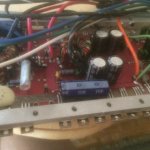Hello,
I have an old Orion 425 hcca (star/moon), one half started blowing fuses.
Right now if I connect 12 V power to one side (no other connections at all), immediately it draws tons of power and tries to blow the fuse.
I have gone through and done main cap replacements, thinking this would be the issue maybe. But the result is the same.
I can't see any obvious signs of damage anywhere.
Thank you in advance for any help or suggestions.
I have an old Orion 425 hcca (star/moon), one half started blowing fuses.
Right now if I connect 12 V power to one side (no other connections at all), immediately it draws tons of power and tries to blow the fuse.
I have gone through and done main cap replacements, thinking this would be the issue maybe. But the result is the same.
I can't see any obvious signs of damage anywhere.
Thank you in advance for any help or suggestions.
Does the other half power up normally?
Yes, it does. I will double check, but yes.
Did you check the output transistors?
Thanks Perry.
I'm not sure how to do that, although I think I know which ones they are. Can this be done without removing them?
I think there are six on each channel? I measured some leg-to-leg impedances and they appear to match the same measurements on the good side.
The only difference I see right now is the bad side impedance measured at the power leads is not the same as that measured on the good side, with no connections.
The only difference I see right now is the bad side impedance measured at the power leads is not the same as that measured on the good side, with no connections.
the impedance between legs 2 and 3 (ordered left to right when viewing from the front) of one of the power transistors in the power supply on the bad side is reading 0.7 Ohms.
I am not seeing that in the corresponding device on the good side, nor in any other power transistor anywhere.
I am not seeing that in the corresponding device on the good side, nor in any other power transistor anywhere.
Is it drawing excessive current without remote voltage?
Yes. As soon as you hook up red/black to 12 Vdc it does.
OK. Desolder that transistor and try it again. Leave it clamped to the heatsink. All you need to do is disconnect the transistor from the circuit board.
If it powers up, you'll need to replace (at the very least) all of the transistors on that half of that power supply.
I'd suggest that you insert a 15 amp fuse in the B+ line to help protect the ampifier there are other problems.
If it powers up, you'll need to replace (at the very least) all of the transistors on that half of that power supply.
I'd suggest that you insert a 15 amp fuse in the B+ line to help protect the ampifier there are other problems.
I am pointing to the one that is showing low impedance in the picture.
So those 6 on that side that you can see in the picture will need to be replace you mean?
I wonder if you know what I should order for the replacements, or even if something can be ordered.
Thanks very much Perry.
So those 6 on that side that you can see in the picture will need to be replace you mean?
I wonder if you know what I should order for the replacements, or even if something can be ordered.
Thanks very much Perry.
Attachments
In the power supply, there are an even number of transistors that drive the transformer and one more that controls power to the drive circuit. I can't tell if that one is wired identically to 4 others or if it's the control transistor. If it's the control transistor, it can be replaced by itself. If it's one of the parallel group, the entire parallel group (5?) transistors are the minimum that you can replace if you want the amp to be reliable.
Don't try to remove them yet. They should be clamped into the heatsink while testing.
When you do remove them, you may bend or break a lot of them. When you do, the best chance of removing them will require something like the following:
http://www.bcae1.com/temp/orionampclamps.swf
When you do remove them, you may bend or break a lot of them. When you do, the best chance of removing them will require something like the following:
http://www.bcae1.com/temp/orionampclamps.swf
Did you desolder the legs and check it out of the circuit (in place but no electrical connection to the board)?
I am about to. I have to take the cap out and reinstall it, etc. Iron warming up.
- Status
- This old topic is closed. If you want to reopen this topic, contact a moderator using the "Report Post" button.
- Home
- General Interest
- Car Audio
- Orion 425 hcca first gen blowing fuses
